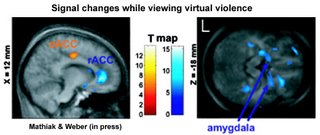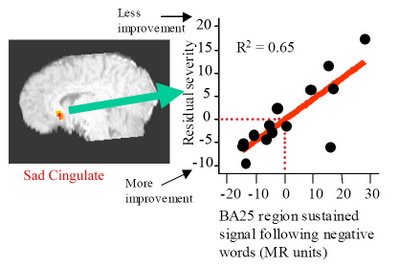Quotidian Virtual Violence
The title of this article (below) and its abstract certainly caught my eye (they actually did use the word "quotidian" and did state that playing violent video games is a natural, real-life behavior).
There are a lot of tricky technical issues involved in recording fMRI under these conditions, but the authors discussed them (e.g., experimenters can't control the time course of stimuli and responses in an interactive game) and developed analytic procedures to deal with these challenges.Human Brain Mapping
Early View (Articles online in advance of print)
Published Online: 20 Apr 2006Toward brain correlates of natural behavior: fMRI during violent video games
Klaus Mathiak, Rene Weber
Modern video games represent highly advanced virtual reality simulations and often contain virtual violence. In a significant amount of young males, playing video games is a quotidian activity, making it an almost natural behavior. Recordings of brain activation with functional magnetic resonance imaging (fMRI) during gameplay may reflect neuronal correlates of real-life behavior. We recorded 13 experienced gamers (18-26 years; average 14 hrs/week playing) while playing a violent first-person shooter game (a violent computer game played in self-perspective) by means of distortion and dephasing reduced fMRI (3 T; single-shot triple-echo echo-planar imaging [EPI]). Content analysis of the video and sound with 100 ms time resolution achieved relevant behavioral variables. These variables explained significant signal variance across large distributed networks. Occurrence of violent scenes revealed significant neuronal correlates in an event-related design. Activation of dorsal and deactivation of rostral anterior cingulate and amygdala characterized the mid-frontal pattern related to virtual violence. Statistics and effect sizes can be considered large at these areas. Optimized imaging strategies allowed for single-subject and for single-trial analysis with good image quality at basal brain structures. We propose that virtual environments can be used to study neuronal processes involved in semi-naturalistic behavior as determined by content analysis. Importantly, the activation pattern reflects brain-environment interactions rather than stimulus responses as observed in classical experimental designs. We relate our findings to the general discussion on social effects of playing first-person shooter games.
Funded by:
TL Foundation
Deutsche Forschungsgemeinschaft (DFG); Grant Number: SFB550/B1, Th812/1-1
U.S. Annenberg Endowment
AstraZeneca
"The present study introduces a procedure to describe interactive behavior as observed during playing a first-person shooter video game in a parametric design.
Content analysis of text and audiovisual stimuli is frequently applied in media research and can be considered a reliable and valid method [Krippendorf, 1980]. Content analysis of video game playing can capture individual interaction patterns within the virtual environment, including violent interactions [Weber et al., 2006]. First-person shooter games are controversially discussed media products but certainly reflect state-of-the-art VR. Taken together, first-person shooter games represent a challenging paradigm for interdisciplinary research of media psychology, communication sciences, and social cognitive neuroscience. The present fMRI study investigated neuronal activity during complex virtual behavior as represented by playing a first-person shooter game with respect to meaningful categories such as violence."
It appears that our old friends the amygdala and the anterior cingulate cortex are involved in virtual violence (but then, the authors focused on these structures a priori). The amygdala and rostral ACC (aka "sad cingulate") showed decreases in activity, and the dorsal ACC (1) showed increases in activity, while the 23 year old German male gamers were engaged in "violent interactions" (relative to "passive/dead" and "preparation/search" states, where there were no violent interactions). The authors' interpretation?
You need use cool rational cognition when shooting at the enemy in "Tactical Ops: Assault on Terror." The media should have a field day with this, but the article isn't in Science or Nature, so we'll see how far it goes without a press release (and with qualifying statements like this one):"This pattern suggested active suppression of affective processing in favor of the cognitive operation."
One might speculate that a frequent training of aggressive neuronal pattern leads to the development of aggressive problem-solving scripts, hostile attribution biases, and normative beliefs approving of aggression as stated by social-cognitive theory [Bandura, 2001]. This proposition with its important implications, however, is not a direct conclusion of this study's findings.
(1) but note that dorsal ACC is also active during empathy for pain, so perhaps the gamers secretly felt sorry for their prey...
Subscribe to Post Comments [Atom]




















